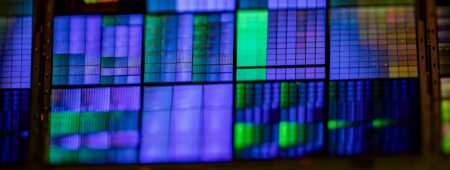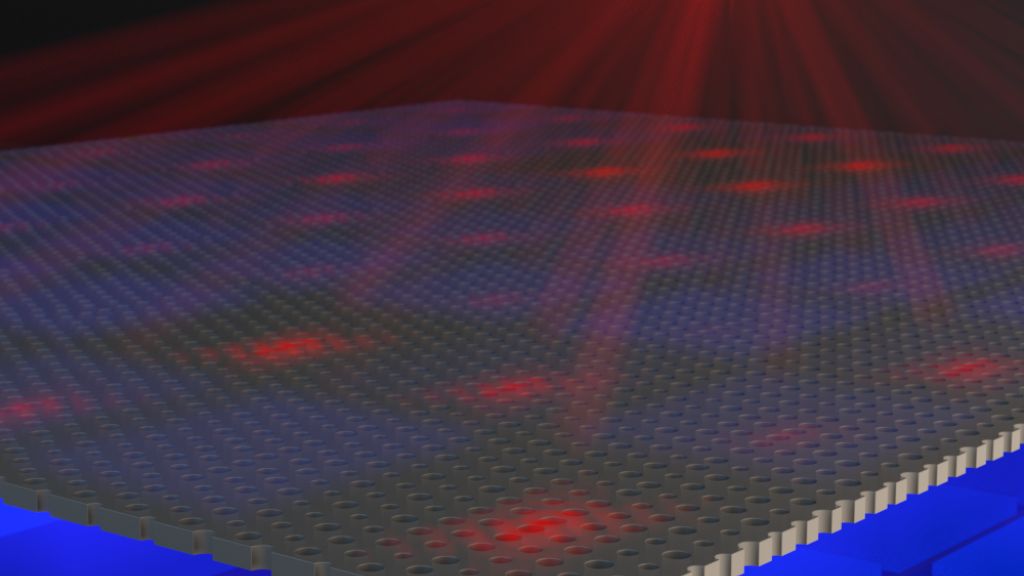
Illuminating the Future of National Security
Working with the U.S. Navy, Hertz Fellow Christopher Panuski is applying his research on optical programming to vital challenges in communication and defense.
If you ever flashed Morse code messages to a friend using a flashlight, then you know that light can contain information. In today’s world, the use of light to encode data is ubiquitous, and far more complex than this kind of rudimentary signaling. Fiber optic cables transmit trillions of bits of information around the world each second, optical switches enable computing accelerators; and speedy, high-resolution imaging and laser technologies allow medical diagnoses, self-driving cars, and large-scale mapping.
Each of these applications of optics relies on the encoding of data in patterns of light. All, however, are therefore limited by how quickly and accurately scientists can control photons — the fundamental particles of light.
Hertz Fellow Christopher Panuski, a Cryptologic Warfare Officer with the U.S. Navy, is pushing the boundaries of optical programming through his development of both hardware and software to control light in new ways. His research has the potential to improve fields as diverse as communications, medicine, and defense — all matters of national security.
“Ultimately, my goal is to blend together my technical background with operational experience to solve today's grand challenges in national defense,” says Panuski. “I’ve been fortunate enough to deploy with the Navy and see how operations actually work in the field. That informs how I develop new technologies.”
As a kid growing up in North Carolina, Panuski loved exploring and tinkering; he was equally likely to be hiking in the woods or rebuilding a car engine. After a high school teacher got him excited about physics, he decided to pursue degrees in engineering and physics at the U.S. Naval Academy. By his senior year, he was carrying out research in optics at the nearby Naval Research Laboratory.
“Optics seemed like a practical application of the circuits I’d loved building in my garage and the rigorous problems that I enjoyed in physics,” says Panuski.
While the Naval Academy doesn’t typically let graduates — who have a commitment to serve in the Navy —pursue PhDs immediately following commissioning, the Hertz Fellowship allowed Panuski to carry on his research at the Massachusetts Institute of Technology (MIT).
“The Hertz Fellowship was absolutely critical for me,” Panuski says. “It opened up the possibility of delving into these very technical fields right out of the academy.”
At MIT, he worked with Dirk Englund at the MIT Quantum Photonics Laboratory on addressing challenges in real-world applications of optics.

“I quickly realized that no matter what the project was, they all ran into this central problem of how to control a bunch of light sources very quickly,” he says.
Some optical systems use single light sources that can be rapidly switched to encode data. Others use arrays of sources that can simultaneously contain their own information— but these arrays are typically much slower. Panuski and Englund wanted both high-speed control and high-density arrays.
Over the course of his graduate work, funded as a Hertz Fellow, Panuski developed new designs for optical microcavities — extremely tiny spaces surrounded by mirrors (like a carnival “Hall of Mirrors” but unimaginably small). Such devices can amplify operations performed on a beam of light so that miniscule changes are easily noticeable.
“You can have a cavity length that’s one-hundredth of the thickness of a human hair, yet light bounces back and forth about one million times before it comes out,” he explains.
Reporting in Nature Photonics in 2022, Panuski unveiled this system, coupled with new techniques to fabricate the optical cavities at a large scale and a proof-of-concept that the cavities can work in arrays of many lights at once — each with their own LED light source to control the corresponding cavity. Overall, the advance allows a high level of control over light in terms of both space and time.
“The combination of having many pixels and being able to modulate those pixels very quickly is useful in a number of problems, including brain imaging and quantum computing,” Panuski says.
In medicine, this kind of improved optical technology could lead to higher-resolution scans, while in defense, it could mean more effective LiDAR (Light Detection And Ranging) to carry out remote sensing.
Today, Panuski is serving his time in the Navy and pursuing the same questions of how optical programming can be improved for practical (and mostly military) applications.
“The ability to transport information with high spatial complexity has immediate applications in the defense space,” he says. “Whether it’s precision measurement, secure communication or LiDAR technology.”
He’s expanded from the fabrication of new hardware — the optical cavities he designed at MIT were physically manufactured — to the development of software that can improve the performance of off-the-shelf optical devices. His software is open-source and he says it’s already being integrated by other research teams around the world.
“There are a lot of devices that have been really exceptional performers in the lab but the challenge has been to get them working in the real-world,” says Panuski.
That’s a challenge he’s ready to meet.
